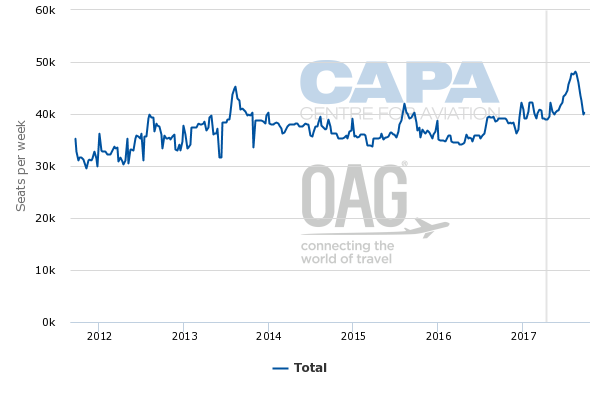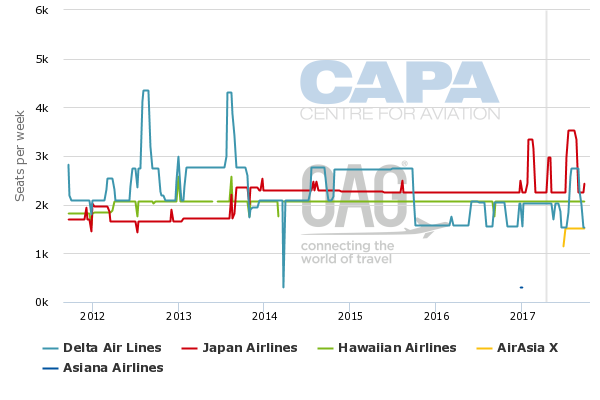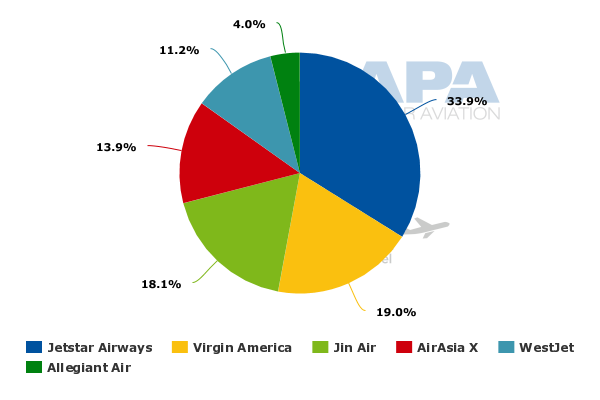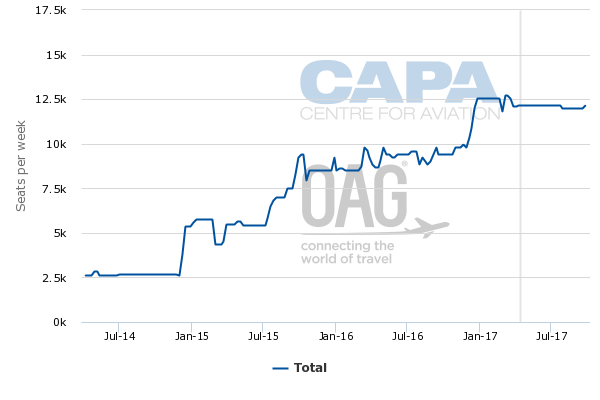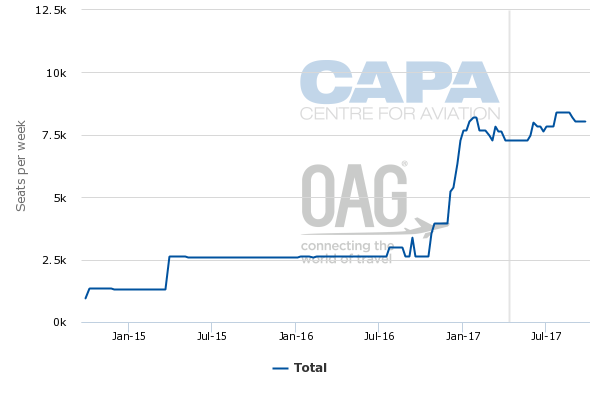AirAsia X to become the ninth Asia Pacific low cost airline serving the US, and the third in Hawaii
Malaysia's AirAsia X is launching services from Osaka to Honolulu in Jun-2017, making it the second LCC to operate from North Asia to Hawaii and the third LCC from Asia-Pacific. The route is made possible by a combination of liberal air service agreements, providing fifth freedom rights to the Malaysian airline. The Korean Air LCC subsidiary Jin Air and Qantas subsidiary Jetstar Airways are currently the only LCCs from Asia Pacific with service to Hawaii - or any of the 50 US states.
AirAsia X secured US FAA approval in Feb-2017, ending a tedious two year process. AirAsia X ibecomes the ninth Asia Pacific LCC to secure US FAA approval and the second from Southeast Asia, after Cebu Pacific. Six Asian LCCs currently serve Guam and five serve Saipan.
Asian LCCs will inevitably also serve the mainland US. Both AirAsia X and Cebu Pacific, along with new Chinese LCCs, have the US west coast in their business plans. Cebu Pacific is the only likely low cost operator of nonstop flights from Southeast Asia to the continental US.
Finally, AirAsia X to launch US flights in Jun-2017
AirAsia X announced in Feb-2017 that its maiden flight to the US would operate on 28-Jun-2017. AirAsia X will initially serve Honolulu with four weekly A330-300 flights from Kuala Lumpur with a stop in Osaka. AirAsia X is unable to serve Honolulu via Tokyo as this is not a permitted fifth freedom route under the current Malaysia-Japan air services agreement.
AirAsia X has been offering one way fares including taxes starting at MYR499 (USD113) for flights from Kuala Lumpur to Honolulu. Promotional one way fares starting at USD99 have been offered between Honolulu and Osaka.
AirAsia X initially unveiled plans in Apr-2015 to serve the Osaka-Honolulu route from Nov-2015. At the time the airline expected it would only take a few months to secure US approvals, which proved to be an overly ambitious time frame. While economic approval from the US DOT is typically a quick process, securing FAA approval is often a long drawn out affair for any new airline that has not previously served the US.
See related report: AirAsia X long-haul low-cost service to the US will provide an important test for the Asian model
Not surprisingly, AirAsia X encountered multiple delays in securing US FAA approvals and had to push back the launch of Hawaii flights several times. Ultimately the approval process took nearly two years.
Honolulu could be the first of several US destinations for AirAsia X
AirAsia X CEO Benyamin Ismail told CAPA TV in Nov-2016 that Osaka-Honolulu could be the first of several US routes. He said flights from Japan to Las Vegas, Los Angeles, and San Francisco are in the group's medium to long term network plan.
See related report: AirAsia X may relaunch London in 2017, potentially with ex-SriLankan A350s
The Malaysia-Japan air services agreement permits fifth freedom services from Tokyo Narita to Los Angeles and San Francisco with a combined cap of eight weekly frequencies. Fifth freedom rights from Tokyo to Las Vegas or any other US city are not provided. However, there are no restrictions on fifth freedom services from other Japanese cities to the US and there is also no cap on Malaysia-Japan capacity levels with the exception of Tokyo Haneda.
Japan-West Coast US flights could potentially be launched in 2019, when AirAsia X takes delivery of its first batch of A330-900neos. Its current fleet of A330-300ceos, which are in 377-seat two class configuration, are able to operate from Japan to Hawaii but lack the range to connect Japan or other North Asian countries with the Continental US.
The longer range new generation A330-900neo opens up North Asia-Continental US routes for AirAsia X and potentially other Asian LCCs. However, nonstop flights from any of AirAsia X's home markets in Southeast Asia - Indonesia, Malaysia and Thailand - to the Continental US would still not be feasible with the A330-900neo.
AirAsia X could potentially use the A350 to operate nonstop flights from Southeast Asia to the US. However, a combination of payload limitations on most potential routes, intense one stop competition and insufficient local demand make such flights a low priority for AirAsia X. Nonstop flights from Southeast Asia to Hawaii are also unlikely, given the lack of local demand.
AirAsia X to rely mainly on Japan-Hawaii traffic
Malaysia-Hawaii is a tiny market and therefore AirAsia X will rely almost entirely on Japan-Hawaii passengers for the second leg of its new Kuala Lumpur-Osaka-Honolulu service.
AirAsia X already serves Kuala Lumpur-Osaka with 10 weekly flights and is adding only one weekly Kuala Lumpur-Osaka frequency (for a total of 11) when it launches the Osaka-Honolulu sector in late Jun-2017. This indicates that AirAsia X only requires a small amount of additional Kuala Lumpur-Osaka capacity as it launches Osaka-Honolulu because most Kuala Lumpur-Osaka passengers will still get off in Osaka, resulting in an almost entirely new set of passengers for Osaka-Honolulu.
Japan-Hawaii is a huge market, with approximately 80,000 weekly return seats currently, increasing to nearly 100,000 weekly seats in the peak northern summer months. This includes approximately 12,000 weekly return seats between Osaka and Hawaii, increasing to up to 20,000 weekly seats in the peak season.
There are nonstop services from several Japanese airports to Honolulu but just one route from Japan to other airports in Hawaii - a thrice weekly service between Tokyo Haneda and Kona that was launched by Hawaiian Airlines in Dec-2016.
Japan-Honolulu total one way seat capacity: Sep-2011 to Sep-2017
The 20,000 weekly return seats in the Osaka-Honolulu market for the peak weeks in Jul-2017 and Aug-2017 include approximately 3,000 seats from AirAsia X, 7,000 seats from Japan Airlines, 6,000 from Delta Air Lines and 4,000 from Hawaiian Airlines.
While AirAsia X will have a relatively modest 15% of seat Osaka-Honolulu seat capacity during the peak periods, its share will increase to approximately 20% during off peak periods as Delta and JAL seasonally reduce capacity.
Osaka to Honolulu one way weekly seat capacity by airline: Sep-2011 to Sep-2017
AirAsia will be the first LCC competing in the Japan-Hawaii market
AirAsia X will the first LCC competing in the Japan-Hawaii market - and in the overall market between Japan and the US 50 states. Korean LCC T'way has been operating fifth freedom services between Japan and the US territory of Guam since late 2015, which made it the first LCC in the broader Japan-US market.
As Japan-Hawaii is almost entirely a leisure market, low fares should stimulate demand and lead to an accelerated rate of growth. However, with only a 3% share of Japan-Hawaii capacity - and a 1% share of total Japan-US capacity - AirAsia X will hardly make a significant impact.
In the 2017 peak summer season there will be approximately 250,000 weekly return seats between Japan and the US. This includes the 100,000 seats between Japan and Hawaii but excludes US territories. There are another 30,000 weekly return seats in the Japan-Guam market, including 2,600 seats from Korea's T'way, and 2,500 weekly return seats in the much smaller Japan-Saipan market.
AirAsia X is also not likely to generate a significant number of self connections from Honolulu to the US mainland, which will limit its impact on the overall Japan-US market. While there are no Asian LCCs serving the Continental US - and no US LCCs operating services to Asia - fares are now low due to intense competition.
Honolulu-Mainland US fares are also generally high - in some cases even higher than Asia-Mainland US fares. LCCs account for only approximately 1% of capacity in the Honolulu-Mainland US market. The combined cost of an AirAsia X Osaka-Honolulu and Honolulu-US West Coast ticket (from an LCC or full service airline) is generally more expensive than an Osaka-West Coast US economy fare on a full service airline.
A much larger proportion of AirAsia X's Hawaii passengers will connect in Asia - although a majority of traffic will be Osaka area residents heading to Hawaii for holiday. The group is planning to offer domestic connections within Japan and to other North Asian countries once the second iteration of AirAsia Japan launches - which is expected in late 2017. AirAsia is also offering connections beyond Kuala Lumpur via its Fly-Thru product, resulting in a competitively priced two stop product in markets such as India-Hawaii and Singapore-Hawaii.
AirAsia X to become eighth Asian LCC to serve the US
In its 10-Feb-2017 Hawaii launch announcement, AirAsia X stated that it was the first Asian LCC to be approved by US authorities. However, actually AirAsia X is the eighth Asian LCC with US approval and an active US operation.
Currently seven Asian LCCs operate services to the US, including Cebu Pacific, Hong Kong Express and five from South Korea - Air Busan, Eastar Jet, Jeju Air, Jin Air and T'way. When the entire Asia Pacific region is taken into account, there are now eight LCCs serving the US, when Australia's Jetstar Airways is added.
Jin and Jetstar are the only widebody or long haul operations among this group. The other six LCCs currently operate narrowbody aircraft to the US territories of Guam and/or Saipan.
Jetstar's LCC operation is the largest in the Honolulu market
Jin and Jetstar serve Honolulu using 777-200ERs and 787-8s respectively. Jetstar has the bigger operation and currently operates eight weekly flights to Honolulu, including five from Sydney and three from Melbourne, generating 5,360 return seats. Jetstar has up to 11 weekly flights to Honolulu during peak periods.
Jin Air serves Honolulu most of the year with five weekly flights from Seoul, generating nearly 4,000 weekly return seats. This service is not currently operating - part of a seasonal suspension that runs from early March to late May.
Jetstar currently has the largest LCC presence in the Honolulu market. Jetstar has more capacity in Honolulu than either of the US LCCs serving Honolulu - Allegiant Air and Virgin America. (Virgin America is still categorised as an LCC but is in the process of being acquired by Alaska Airlines, which is considered a full service airline.)
AirAsia X will be the sixth LCC in the Honolulu market. In early Jul-2017 AirAsia X will account for 14% of total LCC seat capacity in Honolulu. Jetstar, which will have 11 weekly flights to Honolulu in early Jul-2017 for the peak southern winter season, will account for a leading 34%. Jin will account for 18% as its five weekly flights to Honolulu will again be operating during the peak northern summer months.
Honolulu LCC capacity share (% of seats) by airline: 3-Jul-2017 to 9-Jul-2017
While Jetstar's is the largest LCC operation in Hawaii, Jin Air is larger in the overall US market.
Jin currently has approximately 6,600 weekly return seats to/from Guam and 2,600 weekly return seats to/from Saipan. Jin uses the 737-800 on the Seoul-Saipan and Busan-Guam routes but deploys the 777-200ER on Seoul-Guam - although this route is also within narrowbody range.
Jeju Air the largest Asian LCC presence in the US market; AirAsia X will be the smallest
Jin rival Jeju Air has an even larger operation in the US. Jeju Air currently has just 13,000 weekly return seats in the US market, making it the largest Asian LCC operation in the US.
Jeju does not operate widebody aircraft and therefore does not serve Hawaii. However, it is the largest airline operation in the Korea-Saipan market and the second largest in the Korea-Guam market after Korean Air.
Jeju adds capacity to Guam and Saipan during peak periods. In early Jul-2017, Jeju Air will have nearly 15,000 weekly return seats to Guam and Saipan, enabling it to maintain its status as the largest Asian LCC operation in the US market, even as Jin resumes service to Honolulu. With its 3,000 weekly seats, Air Asia X will be the smallest of the nine LCC operations from Asia-Pacific serving the US.
Asia Pacific-US LCC weekly return seat capacity by airline: 3-Jul-2017 to 9-Jul-2017
| Rank | Airline | Weekly seats |
|---|---|---|
| 1 | JEJU air | 14,656 |
| 2 | Jin Air | 12,376 |
| 3 | T'way Air | 7,938 |
| 4 | Jetstar Airways | 7,370 |
| 5 | Eastar Jet | 2,618 |
| 6 | Air Busan | 1,584 |
| 7 | Cebu Pacific | 1,432 |
| 8 | HK Express | 3,240 |
| 9 | AirAsia X | 3,016 |
Guam experiences a surge in Asian LCC capacity
Jeju currently has three daily flights to Guam, including two from Seoul and one from Busan. It also has two daily flights from Seoul to Saipan and a seasonal four times per week service from Busan to Saipan.
Jeju Air launched services to Guam in 2012 and has since rapidly expanded in the Guam market. It has worked closely with Guam tourism authorities and hotels to expand the overall Korea-Guam market, which was previously only served by the Korean Air Group (mainly the full service parent airline, along with some flights by its LCC subsidiary Jin Air).
Air Busan and T'way followed Jeju, launching services to Guam in 2H2015. T'way currently operates a daily service from Seoul to Guam, as well as a daily fifth freedom route from Guam to Osaka. Air Busan, which is partially owned by the full service airline Asiana, operates five weekly flights from Busan to Guam.
Guam attracted two more Asian LCCs in 2016, with new services from Manila by Cebu Pacific (which launched in Mar-2016) and from Hong Kong by HK Express (which launched in Dec-2016). Guam now has 24,000 weekly return LCC seats generated by six Asian LCCs.
Guam's LCC capacity has increased steadily since 2014, when it was served by just one LCC (Jeju Air). Not surprisingly, Korean visitor arrivals to Guam have more than doubled since 2013.
Guam one way weekly LCC capacity: Apr-2014 to Jun-2017
Five LCCs now serve Saipan
HK Express also launched services to Saipan in Jan-2017, becoming the fifth Asian LCC to serve the Saipan market. Jeju also led the way in the Northern Mariana Islands, becoming the first LCC in the market when it launched services to Saipan in 2014. Previously only Asiana served the Korea-Saipan market.
Eastar Jet, Jin Air and T'way all followed Jeju by launching services to Saipan in 2016. There are now almost 15,000 weekly LCC seats in the Saipan market - a significant figure, given that total capacity at Saipan is only 31,000 weekly seats.
Saipan one way weekly LCC capacity: Apr-2014 to Jun-2017
Eastar Jet and HK Express were the latest Asian LCCs to secure FAA approvals, completing the process in 2016. AirAsia X was therefore the eighth LCC from Asia - or the ninth from Asia Pacific to secure FAA approvals. While Guam and Saipan are often considered separate markets to the US 50 states, from a regulatory standpoint they are part of the US, and foreign airlines must go through the same approval process.
For now Asian LCC operations in the US are a small niche - but this will change
Despite the recent growth spurt, Asian LCC operations in the US represent a very small niche. Guam and Saipan are tiny markets, and unique in that they are closer to Asia than the Continental US. Hawaii is also a relatively small and unique market.
Asian LCCs are not likely to become significant players in the Continental US - at least not in the foreseeable future. The long length of flights and current intense level of competition make the Asia-Continental US market difficult to penetrate. The Europe-US market, which is now experiencing rapid LCC growth, is vastly different, due to the much shorter length of flight and the fact that Europe-US fares are generally higher.
There will inevitably be some LCC flights between Asia and the Continental US. AirAsia X is keen to enter the Japan-US West Coast market, possibly as early as 2019. Cebu Pacific is also now evaluating new generation widebody aircraft capable of operating flights from Manila to California.
See related report: Cebu Pacific Air evaluates A350s, 787s & A330neos to support new long haul flights to US west coast
The China-US market will also begin to be served by LCCs in the coming years. Lucky Air is China's first long-haul LCC and will be making Moscow its first destination. Lucky Air will initially fly aircraft with business class seats but will later consider all-economy configurations, amongst other transitions to lower cost practices.
The Singapore Airlines long haul LCC subsidiary Scoot could also launch services from secondary Chinese cities to the US using fifth freedom rights available as part of ASEAN-China open skies agreement.
However, competing in the China-US market will not be easy, given the rapid expansion in the US being pursued by Chinese full service airlines, which has already pressured yields and resulted in LCC like fares. Yields in most other Asia-US markets are also now at all time lows due to extremely intense competition. AirAsia X, Cebu Pacific and at least one Chinese LCC will probably still launch services to the Continental US, but the impact is not likely to be significant for at least the next five years.
